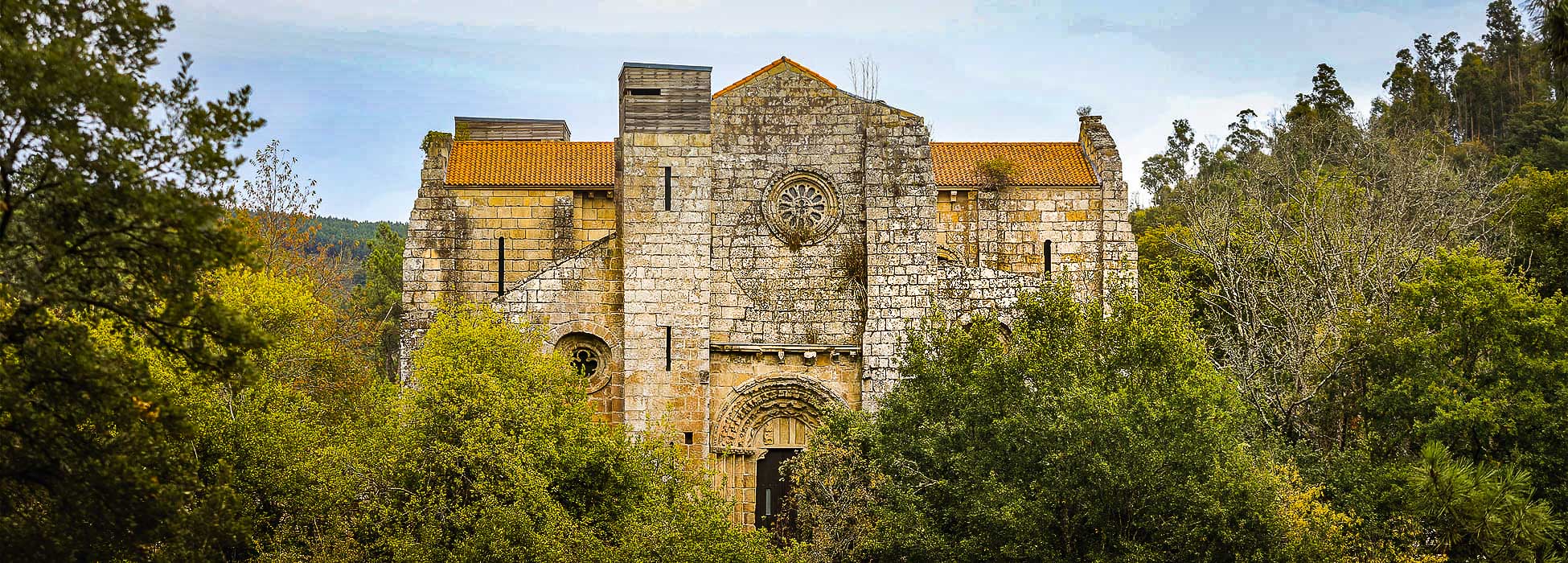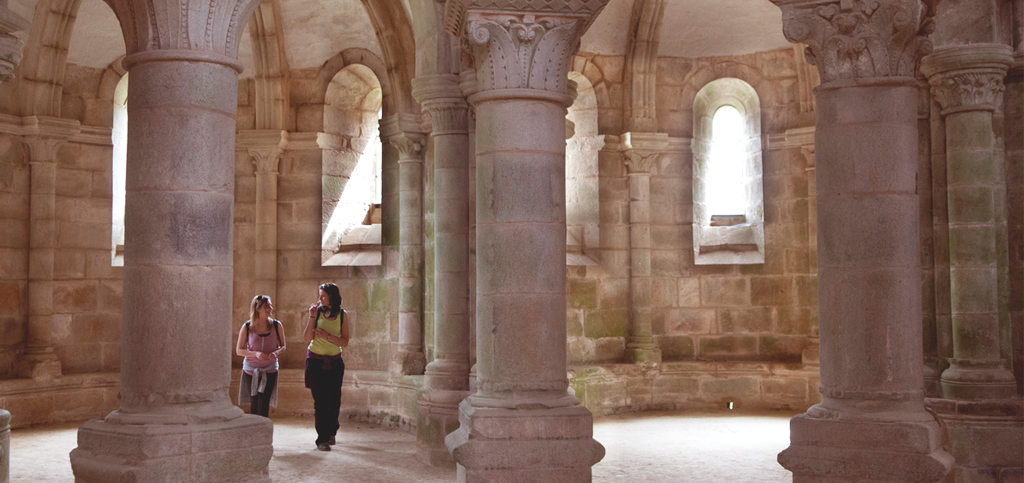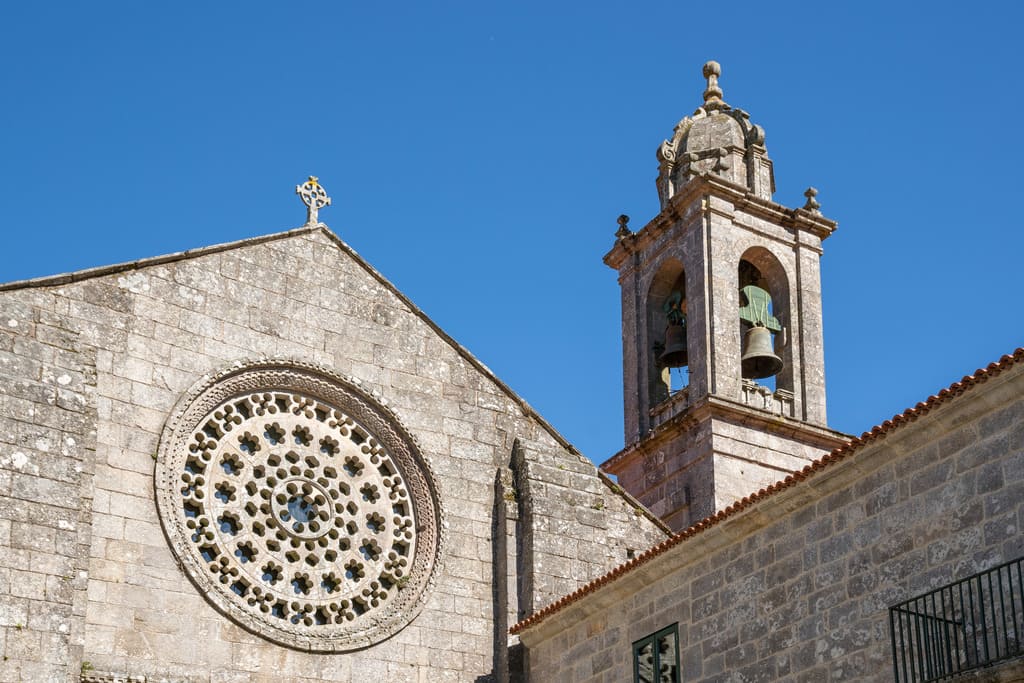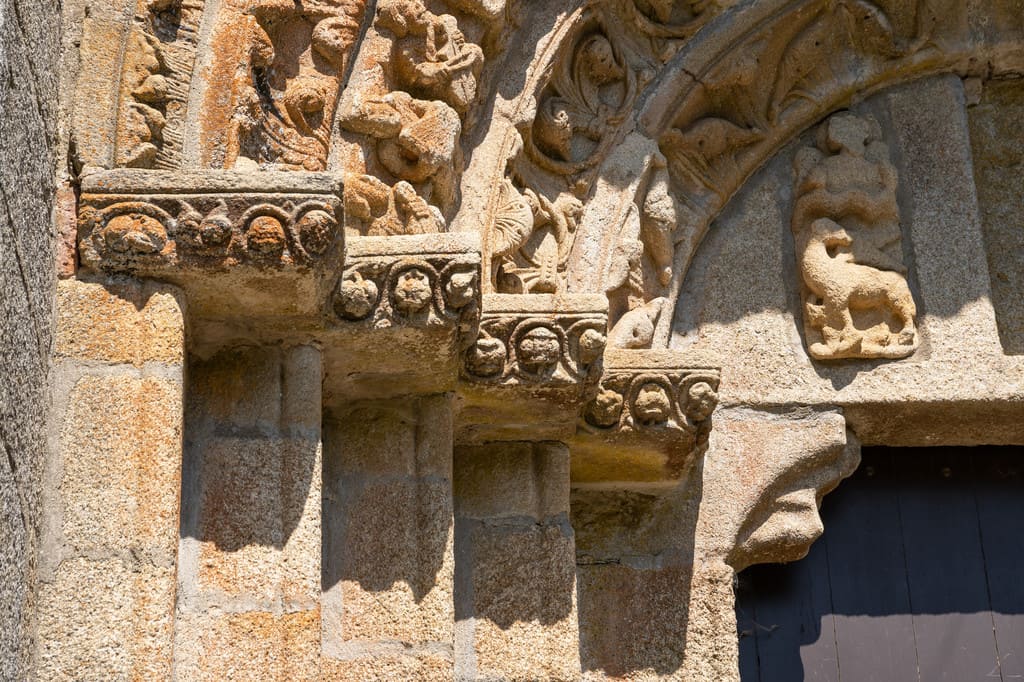Majestic and silent beauty
The monasteries in the province of Pontevedra constitute a millenary heritage surrounded by stunning landscapes. They are perched at the top of the hills (San Lourenzo de Carboeiro), they lay at the bottom of fertile valleys (Santa María da Armenteira) , in meadows close to hilly areas (Santa María de Aciveiro), on the seaside and along the Portuguese Coastal Way (Santa María de Oia), on high plains overlooking the Ría de Pontevedra (San Xoán de Poio) and close to the mouths of large rivers and historical towns (San Salvador de Lérez). These monumental buildings, which have preserved their stillness and majesty intact, are silent witnesses of the passing of centuries.
These religious temples keep a rich legacy. A visit to these buildings will bring you back to a time of kings and Galician noble families, to a period of retreat, land cultivation, battles and revolts. You will have the opportunity to live the medieval splendour of these temples, which is part of the history of the province of Pontevedra.
A tour of the monasteries is one of the biggest tourist attractions in As Rías Baixas. Moreover, it is worth strolling through the surrounding natural landscape to admire its indigenous woods and pastures, the cliffs where the ocean waves brake, the banks of meandering rivers and the magical fervenzas (cascades), some of them smooth and others torrential and powerful ones. A real delight for the senses!
If you want to learn about the history, architecture and decorative elements of the monasteries as well as the legends and quotes by different authors on these majestic temples, it is worth following the so-called Route of the Monasteries. Visit them and enjoy the spiritual magic of the province of Pontevedra.
San Lourenzo de Carboeiro
In the northeast of the province of Pontevedra is the town of Silleda, through which runs the Deza River. In the parish of Carboeiro there is the monastery with the same name, in slow reconstruction. The beauty of this spot came first when choosing it. From above the monastery can be seen, high and almost surrounded by the meander of the river. Its foundation dates back to the second third of the 10th century.
The first house was used to host the primitive community of Cenobites. The construction began in the 11th century, but it was in the 12th century when the monastery would see its heritage constantly increased. Before arriving to Carboeiro, we find the so-called bridge Ponte do Demo (Devil’s bridge), where assaults, murders and other crimes happened. This bridge dates from the 16th century and for centuries it was the only access road between the towns of Silleda and Vila de Cruces.
The church has an ambulatory in the front that is separated from the high altar by a pointed arcade in its lower part. Its upper section boasts semi-circular arches, through which the light gets in. This is a sign of divine grace for those who come into the simple and rocky inside.
Carboeiro was the heart of farming and control of a territory which has been partly filled with villages, hamlets and towns.The Monastery of Carboeiro was declared National Monument by decree on 3 June 1931.
Santa María de Aciveiro
This monastery is located in the town of Forcarei near O Candán Hills, to the west of the Deza River. Nowadays it is totally rebuilt to serve as hostelry with two simple and lovely gardens and the outstanding church has walls and buttresses.
The landscape stands out for its greenness. The hollies (acivros) existing years ago were perhaps what originated the name of this monastery. Frequently, the wintry snow covers the heights, which allowed the monks to get rents for the use of snowdrifts located in their lands. These structures were in the towns of Fixó, Millerada and Forcarei.
The inscription on a wall of the church shows the year of its foundation (1135) which places us once again in the century of the expansion of the Benedictine order in Galicia, the royal donations and the rise of the monastery. As in other cases, some of the abbots of Aciveiro were members of the Galician nobility, who took the vows in the monastery to increase the influence of their lineage. Just as in other monasteries, nature, art and history are combined with legend.
The Monastery of Santa María de Aciveiro was declared National Monument by decree on 3 June 1931. It also belongs to the European Route of Cistercian abbeys and sites and it is member of the Cistercian monasteries association of Galicia ACIGAL.
Santa María de Armenteira
The Monastery of A Armenteira, run by Bernadine nuns, lays on a fertile valley in the town of Meis. King Ferdinand II of León donated several properties to the monastery. In its origins, the monastery also received donations by the Froilaz family. The community of monks had to abandon this monastery in 1837. The reconstruction of this building has its origin in an idea of Carlos Valle-Inclán, who, motivated by his father's work Aromas de leyenda: versos en loor de un santo ermitaño, undertook with a group of collaborators this rebuilding.
What is no history but legend is the dream that Ero and his wife had while they slept: they had no children, but the Virgin Mary assured them that they would have many children. A few days later, they decided to found two monasteries, one for women and the other for men. King Alfonso X's cantiga (medieval poetic song) tells the legend of the couple’s dream. Ero, who felt tired after having walked through his properties, decided to lie down under a tree to sleep for a while... When he woke up, he saw the beautiful monastery he had intended to build. He had slept for 300 years!
The Monastery of A Armenteira was an important centre for vine growing and became the economic hub of the region.The preserved church has a façade in the Romanesque style. Inside, we find three naves; the central one has pointed arches that support the vault, while the lateral ones have semi-circular arches.
The cloister is closed by ribbed vaults decorated with keystones. The Monastery of Santa María da Armenteira was declared National Monument by decree on 3 June 1931.
San Xoán de Poio
This monastery is located on a plain over the inlet Ría de Pontevedra. It was occupied at the end of the 19th century by Mercedarians monks. But it was founded as a Benedictine complex. The oldest written testimony that documented the existence of the monastery of Poio dates from 942 (in the 10th century). In the 18th century, the Father Sarmiento, after climbing the Castrove Hill, left written the following: “En todo cuando anduve de marina, desde O Ferrol hasta A Guarda y Tui, non encontré punto de visión más hermoso, que este sitio de Castrove… Se ve todo lo mejor de Galicia .”(In all my sea travels, from O Ferrol to A Guarda and Tui, I have not found a more beautiful viewpoint than this place in Castrove. The best of Galicia can be admired.)
In 1890 the monks moved into the monastery of Poio, which was in very bad conditions due to the abandonment suffered since 1830. Classes were given in there, the library was retrieved and the church restored, and on 24 September 1959 the construction of the new building began. The aim was to establish a major seminary, but finally it was dedicated to hostelry.
The façade of the church is an evidence of the Baroque style and it has 3 parts. The inside of the church is covered by a big barrel vault, which was finished in 1708. The chapel of Christ houses the sarcophagus of Saint Trahamunda from the 6th century. The main altarpiece is a 17th-century Baroque work with spiral columns, plenty of ornaments and images of saints. The most remarkable are the images of the Virgin of Mercy and Saint John Baptist. This monastery houses a treasure that no other in Galicia has: its library.
The cloister so-called Cruceiro or de los Naranjos hosts the monumental mosaic of the Way of Saint James. It was designed by the Czech artist Antoine Machourek (1913-1991). This work of art is 80 metres long and 2.5 metres high (200 m2). The monastery was declared National Monument on 13 August 1971.San Salvador de Lérez
This monastery is located near the mouth of the Lérez River, in the town of Pontevedra. Its double-arched gallery is adjacent to one of the church walls. It is the destination of a pilgrimage that is held every year on 21 March to pay tribute to Saint Benedict, who has fame of miraculous.There is controversy on the year of its foundation. Father Yepes mentions the end of the 9th century, whereas Father Flórez says it was founded at the beginning of the 10th century.
Some of the abbots later became bishops. In the case of Lérez, during the reign of Fray Benito Gesto, the altarpiece of the high altar of the church was built. The golden colour contributes to the magnificence of this altarpiece, which, like others from the Baroque period, is a symbol of the power of the Church over the unfaithful and Protestant world. This altarpiece, which has a representation of Saint Benedict, dates back from the beginning of the 16th century. The other altarpieces are also part of the artistic and artisan work carried out in this monastery.
There is a small chapel dedicated to Saint. Benedict, which predates the monastery church. It was built between the 17th and 18th centuries. The courtyard, part of the cloister and the main staircase date from the 16th century, according to the work El monasterio de Lérez y su Colegio de Artes, by Crisanto Rial López. The refectory, the kitchen, the chapterhouse, the library and part of the cells are also preserved today. In front of the statue of Saint Benedict there is a lamp which is always lit that contains the miracle oil of the Saint.
The church has a sober façade, which may be attributed to the neoclassical style rather than the Baroque, and over the door there is a statue of Saint Benedict in a niche.The monastery was declared National Monument on 21 June 1946.
Santa María de Oia
The town of Oia is located in a straight coast, similar to the Portuguese coast, and different from the rest of the Galician coast to the north. In this town, we find the Monastery of Oia, close to the sea, which has witnessed many battles to defend the town against the pirates’ attack. This place may have been chosen by the monks as the opposite to calmness; as a metaphor of God’s fury against sin, symbolised by the giant waves.
According to some references, the Monastery of Oia was founded in the early 10th century. The periods of economic growth were followed by periods of decadence, as a consequence of a decline in trade and the wars against Portugal, in the 17th century, the poor harvest and mismanagement of some abbots, especially at the end of the 18th century and the beginning of the 19th century, shortly before the Spanish confiscation and expelling of the monks from the monastery.
In the beginning of the 20th century, at the end of the Portuguese monarchy and after having expelled the Portuguese Jesuit monks, the monastery became their residence and they founded a school. During the Second Spanish Republic, the Jesuits were expelled. In the inside of the church the ribbed vaults, which are richly decorated with filigree, stand out.
One of the monastery's cloisters is a masterpiece of stonework, with semi-circular arches leading to the central courtyard and ribbed vaults that start from elegant corbels. Today the monastery and its premises belong to private owners. The monastery was declared National Monument on 3 June 1931.











